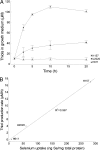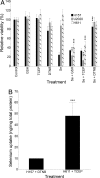Extracellular thiol-assisted selenium uptake dependent on the x(c)- cystine transporter explains the cancer-specific cytotoxicity of selenite
- PMID: 19549867
- PMCID: PMC2708693
- DOI: 10.1073/pnas.0902204106
Extracellular thiol-assisted selenium uptake dependent on the x(c)- cystine transporter explains the cancer-specific cytotoxicity of selenite
Abstract
The selenium salt selenite (SeO(3)(2-)) is cytotoxic in low to moderate concentrations, with a remarkable specificity for cancer cells resistant to conventional chemotherapy. Our data show that selenium uptake and accumulation, rather than intracellular events, are crucial to the specific selenite cytotoxicity observed in resistant cancer cells. We show that selenium uptake depends on extracellular reduction, and that the extracellular environment is a key factor specific to selenite cytotoxicity. The extracellular reduction is mediated by cysteine, and the efficacy is determined by the uptake of cystine by the x(c)(-) antiporter and secretion of cysteine by multidrug resistance proteins, both of which are frequently overexpressed by resistant cancer cells. This mechanism provides molecular evidence for the existence of an inverse relationship between resistance to conventional chemotherapy and sensitivity to selenite cytotoxicity, and highlights the great therapeutic potential in treating multidrug-resistant cancer.
Conflict of interest statement
The authors declare no conflict of interest.
Figures






References
-
- Björkhem-Bergman L, et al. Drug-resistant human lung cancer cells are more sensitive to selenium cytotoxicity: Effects on thioredoxin reductase and glutathione reductase. Biochem Pharmacol. 2002;63:1875–1884. - PubMed
-
- Nilsonne G, et al. Selenite induces apoptosis in sarcomatoid malignant mesothelioma cells through oxidative stress. Free Radical Biol Med. 2006;41:874–885. - PubMed
-
- Kumar S, Björnstedt M, Holmgren A. Selenite is a substrate for calf thymus thioredoxin reductase and thioredoxin and elicits a large non-stoichiometric oxidation of NADPH in the presence of oxygen. Eur J Biochem. 1992;207:435–439. - PubMed
-
- Yan L, Spallholz JE. Generation of reactive oxygen species from the reaction of selenium compounds with thiols and mammary tumor cells. Biochem Pharmacol. 1993;45:429–437. - PubMed
-
- Lu J, Kaeck M, Jiang C, Wilson AC, Thompson HJ. Selenite induction of DNA strand breaks and apoptosis in mouse leukemic L1210 cells. Biochem Pharmacol. 1994;47:1531–1535. - PubMed
Publication types
MeSH terms
Substances
LinkOut - more resources
Full Text Sources
Other Literature Sources
Medical

